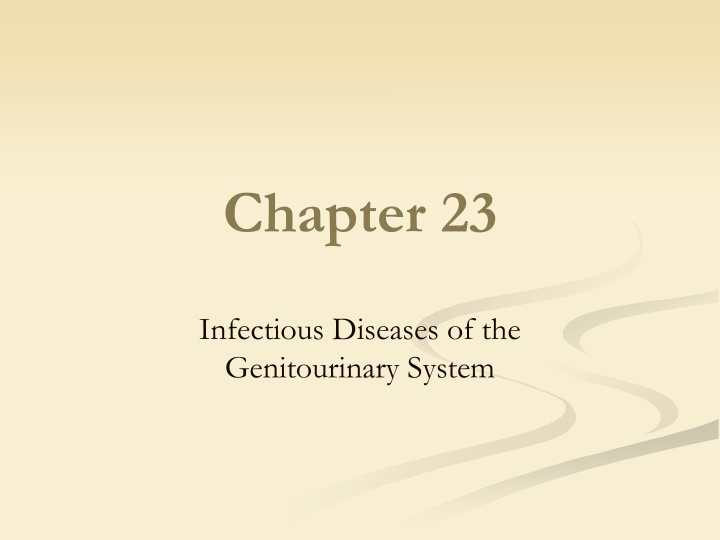
Genitourinary and Reproductive Tract Infections
Learn about infectious diseases affecting the genitourinary and reproductive systems, including urinary tract infections and vaginitis. Explore causes, symptoms, and treatment options for common conditions like cystitis and yeast infections.
Download Presentation

Please find below an Image/Link to download the presentation.
The content on the website is provided AS IS for your information and personal use only. It may not be sold, licensed, or shared on other websites without obtaining consent from the author. If you encounter any issues during the download, it is possible that the publisher has removed the file from their server.
You are allowed to download the files provided on this website for personal or commercial use, subject to the condition that they are used lawfully. All files are the property of their respective owners.
The content on the website is provided AS IS for your information and personal use only. It may not be sold, licensed, or shared on other websites without obtaining consent from the author.
E N D
Presentation Transcript
Chapter 23 Infectious Diseases of the Genitourinary System
Diseases of the Urinary Tract 23.3 Urinary Tract Diseases Caused by Microorganisms A. Urinary Tract Infections (UTIs) 1. Urine is a good growth medium for many microorganisms 2. Reduced urine flow or accidental introduction of bacteria into the bladder can result in cystitis
Diseases of the Urinary Tract 3. If the infection also affects the kidneys it is called pyelonephritis 4. An infection only in the urethra is known as urethritis
Diseases of the Urinary Tract B. Bacterial Cystitis 1. Common urinary infection that involves the inflammation of the bladder = cystitis A) About 30% of all women develop cystitis at some time during their life 2. Most urinary tract infections originate from normal intestinal flora such as E. coli (80-90%), Staphylococcus saprophyticus, and Klebsiella & Proteus sp.
Diseases of the Urinary Tract 3. Nosocomial urinary tract infections are commonly caused by Pseudomonas, Serratia, and Enterococcus which commonly grow on catheters 4. Characterized by a sudden onset of symptoms A) Pain in the pubic area B) Frequent urges to urinate even when the bladder is empty
Diseases of the Urinary Tract C) Burning pain accompanying urination (dysuria) D) Cloudy urine E) Orange tinge to the urine (hematuria) F) Fever and nausea G) Back pain indicates kidneys may also be involved
Diseases of the Reproductive Tract 23.4 Reproductive Tract Diseases Caused by Microorganisms A. Vaginitis and Vaginosis 1. Common infections of the vagina; not considered STD s A) Vaginal itching to varying degrees B) Burning and sometimes a discharge occurs C) Symptoms depend on the causative agent
Diseases of the Reproductive Tract 1) Candida albicans (yeast infection) a) Vulvovaginal candidiasis (vaginitis) is the second most common cause of vaginal symptoms which include: itching, burning, thick white vaginal discharge, redness and inflammation b) A yeast that is part of the normal vaginal flora in 35% of women c) Considered non-contagious and is usually not sexually transmitted
Diseases of the Reproductive Tract 2) Gardnerella sp. a) Causes vaginosis (as opposed to vaginitis) as inflammation in the vagina does not occur b) Is the most common cause of non STD vaginal symptoms c) Vaginal discharge with a pungent fishy odor, especially after sex d) Itching is common
Sexually Transmitted Diseases Resulting in a Discharge B. Three broad categories of sexually transmitted diseases 1. Discharge diseases 2. Ulcer diseases 3. Wart diseases
Sexually Transmitted Diseases Resulting in a Discharge C. Discharge Diseases 1. Increase in fluid discharge in male and female reproductive tracts 2. Includes trichomoniasis, gonorrhea, and chlamydia
Sexually Transmitted Diseases Resulting in a Discharge A) Trichomoniasis 1) Causative agent is Trichomonas vaginalis 2) Asymptomatic infections in approximately 50% of females and males 3) Symptoms include the production of a frothy, green or yellow discharge
Sexually Transmitted Diseases Resulting in a Discharge B) Gonorrhea ( clap ) 1) Caused by Neisseria gonorrheae also known as the gonococcus 2) Number of reported cases has greatly reduced since the 1970s (more than 1 million down to less than 350,000)
Sexually Transmitted Diseases Resulting in a Discharge 3) Men usually develop painful urination and a thick yellow discharge from the penis a) Can occasionally spread from the urethra to the prostate gland and epididymis 4) Women tend to have less severe symptoms or are asymptomatic and more likely to be unknowing carriers
Sexually Transmitted Diseases Resulting in a Discharge a) Symptoms include a mucopurulent or bloody vaginal discharge often accompanied by a UTI b) 15-30% of untreated cases ascend beyond the vagina and cervix to infect higher reproductive organs resulting in pelvic inflammatory disease (PID) i) The associated damage and inflammation increases the risk for ectopic pregnancies
Sexually Transmitted Diseases Resulting in a Discharge 5) Inflammatory responses to infection can cause scarring which can partially obstruct the urethra or cause sterility in both men and women 6) N. gonorrhoeae can also cause other problems including proctitis resulting from anal sex, pharyngitis & gingivitis resulting from oral sex, and conjunctivitis in newborns of infected mothers
Sexually Transmitted Diseases Resulting in a Discharge C) Chlamydial Infections 1) The causative agent is Chlamydia trachomatis 2) 70-85% of females and 10-25% of males are asymptomatic
Sexually Transmitted Diseases Resulting in a Discharge a) In males the bacteria causes urethritis, a gray- discharge from the penis and painful testes b) In women it results in cervicitis accompanied by white drainage, abdominal pain, endometritis, and pelvic inflammatory disease
Sexually Transmitted Diseases Resulting in a Discharge 3) The bacteria enters through tiny nicks or breaks in the perigenital skin or the mucus membranes a) The surrounding lymph nodes may become infected causing them to enlarge and harden i) The nodes may then burst and heal resulting in scarring that can inhibit functionality of surrounding structures
Sexually Transmitted Diseases Resulting in a Discharge 4) Babies born to mothers with infections can develop eye infections and pneumonia
Sexually Transmitted Diseases Resulting in a Ulcer D. Genital Ulcer Diseases 1. Two common infectious conditions resulting in lesions on a person s genitals are syphilis and genital herpes A) Having one of these diseases increases the chances of infection with HIV because of the open lesions
Sexually Transmitted Diseases Resulting in a Ulcer 2. Syphilis A) Caused by the spirochete Treponema pallidum B) Syphilis is often called the great imitator because it symptoms resemble many other diseases C) There are three stages of syphilis
Sexually Transmitted Diseases Resulting in a Ulcer 1) Primary syphilis a) A hard chancre, usually painless, forms at the site of inoculation on the internal or external genitalia b) Usually heals without treatment in 3-6 weeks but the disease is still present
Sexually Transmitted Diseases Resulting in a Ulcer 2) Secondary syphilis a) Usually begins about 6 weeks after the chancre heals b) Initial symptoms are fever, headache, and sore throat c) These progress into infection of the lymph nodes and a rash covering the whole body
Sexually Transmitted Diseases Resulting in a Ulcer d) Symptoms usually disappear in a few weeks e) About 30% of infected individuals enter into a period of latency following secondary syphilis i) Can last for many, many years 3) Tertiary syphilis a) If the patient enters the tertiary stage the complications are serious
Sexually Transmitted Diseases Resulting in a Ulcer i) Cardiovascular syphilis results in the small arteries of the heart becoming weak & rupturing causing heart failure ii) Syphilitic tumors can form on the liver, skin, bone, and cartilage iii) Neurosyphilis can infect the brain, cranial nerves, and dorsal root of the spinal cord
Sexually Transmitted Diseases Resulting in a Ulcer 4) Syphilis that infects pregnant women can spread across the placenta to involve the fetus = congenital syphilis a) Symptoms can range from mild to extreme depending on when exposure occurred
Sexually Transmitted Diseases Resulting in a Ulcer 3. Genital Herpes A) Caused by herpes simplex viruses (HSVs); usually HSV-2 B) Symptoms: groups of vesicles with itching, burning, or painful sensations and local lymph node enlargement C) Many persons have no symptoms while others have frequent recurrences (generally less severe than original outbreak)
Sexually Transmitted Diseases Resulting in a Ulcer 1) A latent form of the virus establishes itself in the ganglia of sensory neurons and cannot be cured D) Transmission can occur in the absence of symptoms but the risk is much higher when lesions are present
Sexually Transmitted Diseases Resulting in a Ulcer E) Drugs of choice include Acyclovir (Zovirax) and Valacyclovir (Valtrex) F) In the neonate and fetus, HSV infections are very destructive and can be fatal
Sexually Transmitted Diseases Resulting in a Wart E. Wart Diseases 1. Human papillomavirus (HPV) A) Causative agents of genital warts B) An individual can be infected with HPV without having warts, however
Sexually Transmitted Diseases Resulting in a Wart 2. Molluscum Contagiosum A) Caused by a virus of the pox family B) Can take the form of skin lesions similar to HPV (usually have smooth instead of a rough surface)






















